XFX’s Radeon HD 7970 Black Edition Double Dissipation: The First Semi-Custom 7970
by Ryan Smith on January 9, 2012 6:00 AM ESTThe Test, Power, Temp, & Noise
| CPU: | Intel Core i7-3960X @ 4.3GHz |
| Motherboard: | EVGA X79 SLI |
| Chipset Drivers: | Intel 9.2.3.1022 |
| Power Supply: | Antec True Power Quattro 1200 |
| Hard Disk: | Samsung 470 (240GB) |
| Memory: | G.Skill Ripjaws DDR3-1867 4 x 4GB (8-10-9-26) |
| Video Cards: |
XFX Radeon HD 7970 Black Edition Double Diss. AMD Radeon HD 7970 AMD Radeon HD 6990 AMD Radeon HD 6970 AMD Radeon HD 6950 AMD Radeon HD 5870 AMD Radeon HD 5850 AMD Radeon HD 4870 NVIDIA GeForce GTX 590 NVIDIA GeForce GTX 580 NVIDIA GeForce GTX 570 NVIDIA GeForce GTX 470 NVIDIA GeForce GTX 285 |
| Video Drivers: |
NVIDIA ForceWare 290.36 Beta AMD Catalyst Beta 8.921.2-111215a |
| OS: | Windows 7 Ultimate 64-bit |
We’ll start things in reverse today by first looking at the power, temperature, & noise characteristics of the 7970 BEDD. The custom cooler is the single biggest differentiating factor for the BEDD, followed by its factory overclock.
| Radeon HD 7900 Series Voltages | ||||
| Ref 7970 Load | Ref 7970 Idle | XFX 7970 Black Edition DD | ||
| 1.17v | 0.85v | 1.17v | ||
As we noted in our introduction, the BEDD ships at the same voltage as the reference 7970: 1.17v. Since XFX is using the AMD PCB too, the power characteristics are virtually identical, save for the overclock and the power draw of the two fans.
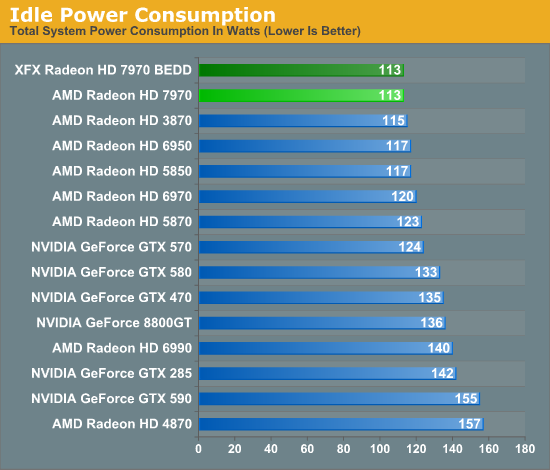
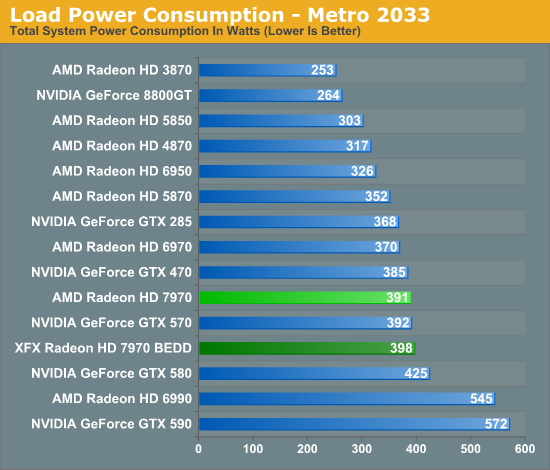
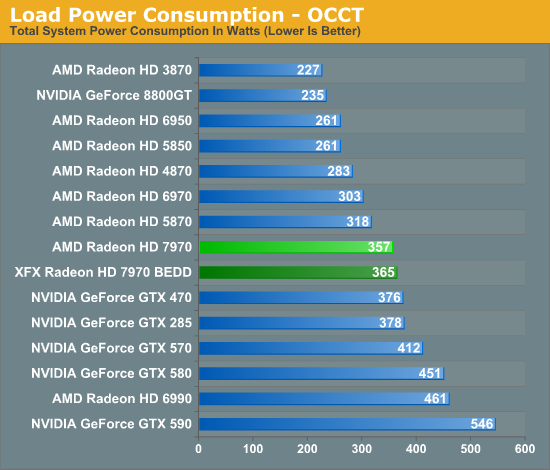
Even with two fans the idle power consumption of the BEDD is identical to the reference 7970. Meanwhile under load we see that the power consumption for the BEDD creeps up slightly compared to the reference 7970. With Metro 2033 we see system power consumption peak at 398W, 7W over the reference card, meanwhile under OCCT system power consumption peaks at 365W, 8W over the reference card.
It’s worth noting that as XFX has not touched the PowerTune limits for the BEDD, it’s capped at the same 250W limit as the reference 7970 by default. So far we haven’t seen any proof that the BEDD is being throttled at this level under any of our games or compute benchmarks, however we can’t completely rule this out as we still don’t have any tools that can read the real clockspeed of the 7970 when PowerTune throttling is active. Whenever an overclock is involved there’s always a risk of hitting that PowerTune limit before a card can fully stretch its legs, hence the need to be concerned about PowerTune if it hasn’t already been adjusted. As for our power tests, the difference seems to largely boil down to the higher power consumption of XFX’s fans when they’re operating above idle.

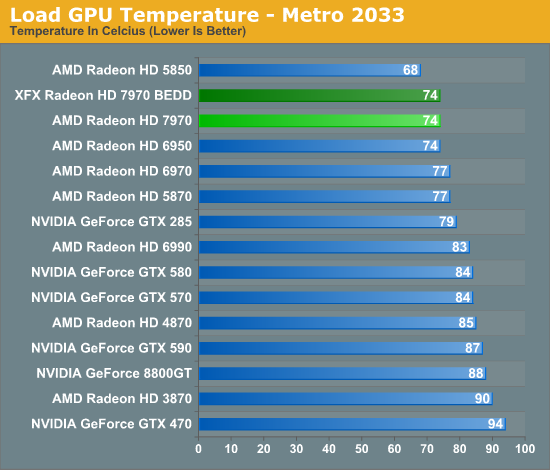
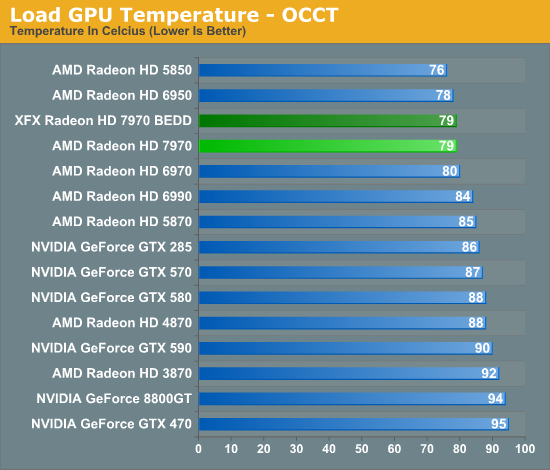
One of the key advantages of open air designs is that they do a better job of dissipating heat from the GPU, which is what we’re seeing here with the BEDD under idle. At 30C the BEDD is 4C cooler than the reference 7970, with all of that being a product of the Double Dissipation cooler.
However it’s interesting to note that temperatures under load end up being identical to the reference 7970. The BEDD is no cooler than the reference 7970 even with its radically different cooling apparatus. This is ultimately a result of the fact that the BEDD is a semi-custom card; not only is XFX using AMD’s PCB, but they’re using AMD’s aggressive fan profile. At any given temperature the BEDD’s fans ramp up to the same speed (as a percentage) as AMD’s fans, meaning that the BEDD’s fans won’t ramp up until the card hits the same temperatures that trigger a ramp-up on the reference design. As a result the BEDD is no cooler than the reference 7970, though with AMD’s aggressive cooling policy the reference 7970 would be tough to beat.
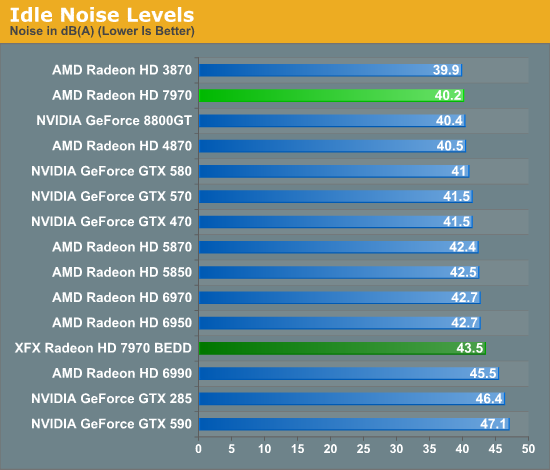
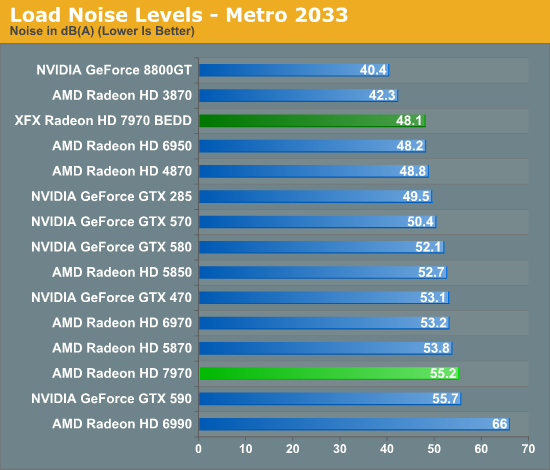
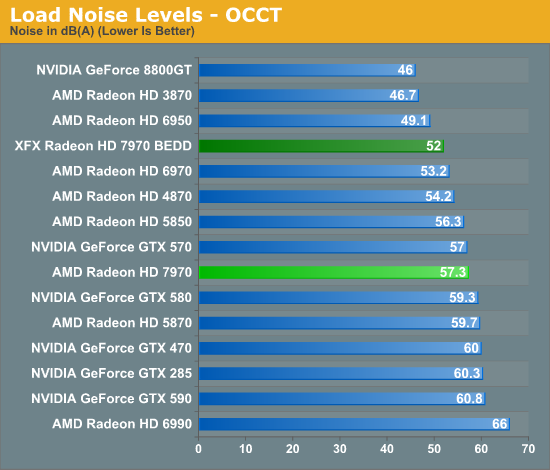
Finally taking a look at noise we can see the full impact of XFX’s replacement cooler. For XFX this is both good and bad. On the bad side, their Double Dissipation cooler can’t match the 7970 reference cooler when idling; 43.5dB isn’t particularly awful but it’s noticeable, particularly when compared to the reference 7970. Consequently the BEDD is definitely not a good candidate for a PC that needs to be near-silent at idle.
On the flip side under load we finally see XFX’s cooler choice pay off. AMD’s aggressive fan profile made the reference 7970 one of the loudest single-GPU cards in our lineup, but XFX’s Double Dissipation cooler fares significantly better here. At 48.1dB under Metro it’s not only quieter than the reference 7970 by a rather large 7dB, but it’s also quieter than every other modern high-end card in our lineup, effectively tying with the reference 6950. Even under our pathological OCCT test it only reaches 52dB, 5dB quieter than the reference 7970.
Ultimately where the BEDD was a poor candidate for noise under idle, it’s an excellent candidate for a quiet computer under load thanks to the open air nature of XFX’s Double Dissipation cooler, and certainly the launch card to get if you want a load-quiet 7970. Just don’t throw it directly up against another card in CrossFire, as these open air cards typically fare poorly without an open slot to work with.










93 Comments
View All Comments
Death666Angel - Monday, January 9, 2012 - link
You should read the launch article. But in case you won't:"At the 7970’s core clock of 925MHz this puts Tahiti’s theoretical FP32 compute performance at 3.79TFLOPs, while its FP64 performance is ¼ that at 947GFLOPs. As GCN’s FP64 performance can be configured for 1/16, ¼, or ½ its FP32 performance it’s not clear at this time whether the 7970’s ¼ rate was a hardware design decision for Tahiti or a software cap that’s specific to the 7970. However as it’s obvious that Tahiti is destined to end up in a FireStream card we will no doubt find out soon enough."
R3MF - Wednesday, January 11, 2012 - link
many thanks, must have missed that first time around.cyrusfox - Monday, January 9, 2012 - link
Its great that you still include Starcraft 2 results, you're about the only site that still constantly includes that game, and as that game has odd issues on amd cpus and gpus, its good to know this card still scales well on that game. Appreciate that you still bench it Ryan. Thanksgeniekid - Monday, January 9, 2012 - link
++I understand that FPSes are usually the most graphically taxing games, but SC2 and Civ 5 show that there are other genres that take advantage of graphical processing power. Plus, it's always nice to see benchmarks for games I actually play :)
vol7ron - Monday, January 9, 2012 - link
Agreed for all the above.I used to love that Counter Strike was included in all the benchmarks. Realizing that game no longer saw any true benefit from a new GPU some odd years ago; but it was nice to see in the charts here on AT for posterity. BTW, I think Steam is developing a new engine for CS; maybe AT would like to do some reviews of software version differences.
chizow - Monday, January 9, 2012 - link
AMD and its fans can't really claim they're the champions of the poor and downtrodden budget enthusiast anymore with the 7970's pricing. I mean the pricing looks OK compared to last-gen parts as of today, but I don't think that's going to be the case when Nvidia releases their Kepler parts in the next few months.Nvidia has a great opportunity with Kepler to do what AMD did to them a few years ago with Cypress....which is make the opposition look really bad with regard to pricing and win back some of that mindshare and goodwill AMD has built up over the years. If the high-end Kepler part ends up 15-20% faster than the 7970 as many expect and is priced at $500 like the last 2 Nvidia flagship single-GPU parts, I wonder if AMD will be the one issuing rebate checks?
I always considered the 4870 a pricing mistake on AMD's part where they failed to capitalize on a successful part. What's clear is that AMD also realized their mistake and have made steps to correct their pricing over the years:
4870 $299
5870 $379 (raised to ~$430)
6970 $369
7970 $549!!!
In the past, even when ATI was running 2nd for the generation behind Nvidia, they provided users value at a price point that made sense against that generation's competitor parts. I don't think that will hold true in this case when Kepler is finally released, and AMD will have to suffer those consquences (similar to Nvidia and GT200).
Will be fun to see how it shakes out either way, but its good to see AMD trying to make a buck or two and put the charitable spin to rest for good.
SlyNine - Monday, January 9, 2012 - link
I'm really hoping they lower the price.I bought 2 8800GTs 512 (when it first came out) and the 5870 when it first came out. I knew both those cards values were over the top. Proven by the fact that the cost went up soon after I bought them.
My point is there can be value at the very high end, the 5870 is proof of that. This card can not touch what the 5870, 4870, 9700pro, 8800GT was in value at the time of release. If this card is the card that made them switch to AMD then they were not paying attention.
Morg. - Tuesday, January 10, 2012 - link
They will lower the price, because nVidia will try to compete.They're just taking advantage of the current position of the 7970 : first 28nm gpu.
chizow - Tuesday, January 10, 2012 - link
Well I think those are all valid case points and extremely impressive parts, but the reality of it is, the 5870's pricing was just a result of the fallout from the 4870.If you look back, as fast as the 5870 was, it was still in a similar position as the 7970 is today, only 15-25% faster than the GTX 285. The GTX 285 launched at only $380 as a die-shrink refresh of the 280. All prices around that time were badly deflated due to price wars, the economy, but most importantly, the 4870's pricing. So when the 5870 launched at the end of 2009, they couldn't price it any higher at first, but once it became clear Nvidia didn't have a 40nm response in 2009, they quickly jacked up the price.
Overall though I think value just depends on where you are in the upgrade cycle with either Nvidia or AMD and how much of an improvement you need to see before you upgrade. If you're with Nvidia right now with a 480/580, the 7970 doesn't really look all that great for 15-25% more performance at $550. It makes more sense to wait for Kepler for that expected 50% increase at roughly the same price point.
But it might be worth it for an AMD user who's going to see 50%+ gains from a 6970/5870. Still, one has to wonder if that performance is worth it for such a huge increase in price, which again, is the position AMD has put itself in based on their historical pricing.
Morg. - Tuesday, January 10, 2012 - link
The 15-25% performance is wrong.drivers are beta at best
resolution reviewed are typically where the 580 shines
the 6970 was about 5% worse than a 580 above full HD . don't know where you get 50% but that's great for you.
No top card ever looked great at its top card price. that's not the point of the top card.